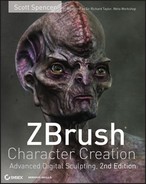Starting a head from a simple sphere primitive has several benefits. Sculpting character heads from spheres in ZBrush is a valuable exercise, similar to sketching on paper or with a digital ball of clay. Also, approaching a complex form in ZBrush from such a simple primitive helps to illustrate how topology in ZBrush is not a major concern, provided that the polygon count of your base model is low enough that it can be subdivided to the maximum level. The higher your subdivision levels, the more polygons you will have to push and pull into the shapes you need. Please see the accompanying DVD for a video of the head sculpture from this chapter. You will also find a bonus DVD of an alien sculpture that was created from a ZBrush primitive sphere.
At this time I’d like to introduce you to the concept of multiresolution editing. Multiresolution editing means that changes you make at level 1 on a ZTool telegraph all the way up to the highest subdivision level; changes at the high levels are telegraphed down to level 1 (Figure 2-1).
Figure 2-1: The werewolf head on the left was altered with the Move tool at level 1. Stepping up to level 3, the changes are telegraphed through each subdivision level and affect each one.

Because of this interaction between subdivision levels, when the artist works at the lowest possible level, any forms made will translate to the higher levels. This workflow helps reinforce the “big shapes to smaller details” we discussed in Chapter 1, “Sculpting, from Traditional to Digital.” When you create the big shapes first and work down to the details, your sculpture maintains a solid sense of form. By working at lower subdivision levels, you won’t deal with enough geometry to become lost in details. This ensures that you focus on big shapes first and then add details as you begin to subdivide. This is the process we used in Chapter 1 for the lion head. This kind of approach also helps create a smooth and organic surface without the “lumpiness” seen in some ZBrush models.
Although it is desirable to work at the lowest possible subdivision level for the form you are creating, some ZBrush brushes work differently at the higher subdivision levels. The Rake and Clay brushes, for example, are more effective at the higher subdivision levels. The kind of form that these brushes build is rough, so the focus is still on building basic large shapes first and then working down to the details. This process is closer to sculpting in actual clay, as you use larger rakes and broad strokes to create base forms and then refine them with tighter and smaller strokes until the surface is smoothed and finished. This latter process is the one we’ll use for the human head sketch in this chapter. I use a combination of both working on the lowest levels with some brushes and then higher levels with Clay and Rake tools, but it is important to understand each approach and its merits. Most of all, always remember to work on the biggest shapes first and work your way down to the details.
